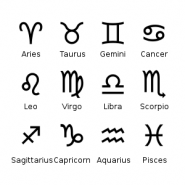Source: Statistics Brain

| Statistic Verification |
| Source: XtraAstrology, Cafe Astrology |
| Date Verified: 7.26.2012 |
| In both astrology and historical astronomy, the zodiac is a circle of twelve 30° divisions of celestial longitude that are centered upon the ecliptic: the apparent path of the Sun across the celestial sphere over the course of the year. The concept of the zodiac originated in Babylonian astrology, and was later influenced by Hellenistic culture. According to astrology, celestial phenomena relate to human activity on the principle of “as above, so below”, so that the signs are held to represent characteristic modes of expression[1], or specific qualities of experience, through which planets manifest their dimension of experience. |
| Zodiac Statistics | |
| Percent of astrology readers that are women | 75% |
| Percent of americans that believe in astrology | 33% |
| Total amount of websites that come when searching “astrology” on google | 2 million |
| Total number of professional astrologers in the U.S. | 7,000 |
| Total amount of zodiac signs in the original zodiac calendar | 18 |
| Total amount of degrees in each Zodiac ecliptic | 30 degrees |
| Total amount of different personality types in the zodiac | 4 |
| Most Common to Least Common Zodiac Signs | ||
| Rank | Zodiac Sign | Percent of US Population |
| 1 | Scorpio | 0.094 % |
| 2 | Virgo | 0.093 % |
| 3 | Gemini | 0.092 % |
| 4 | Pisces | 0.090 % |
| 5 | Libra | 0.087 % |
| 6 | Cancer | 0.084 % |
| 7 | Taurus | 0.083 % |
| 8 | Capricorn | 0.082 % |
| 9 | Aries | 0.081 % |
| 10 | Sagittarius | 0.073 % |
| 11 | Leo | 0.071 % |
| 12 | Aquarius | 0.063 % |









